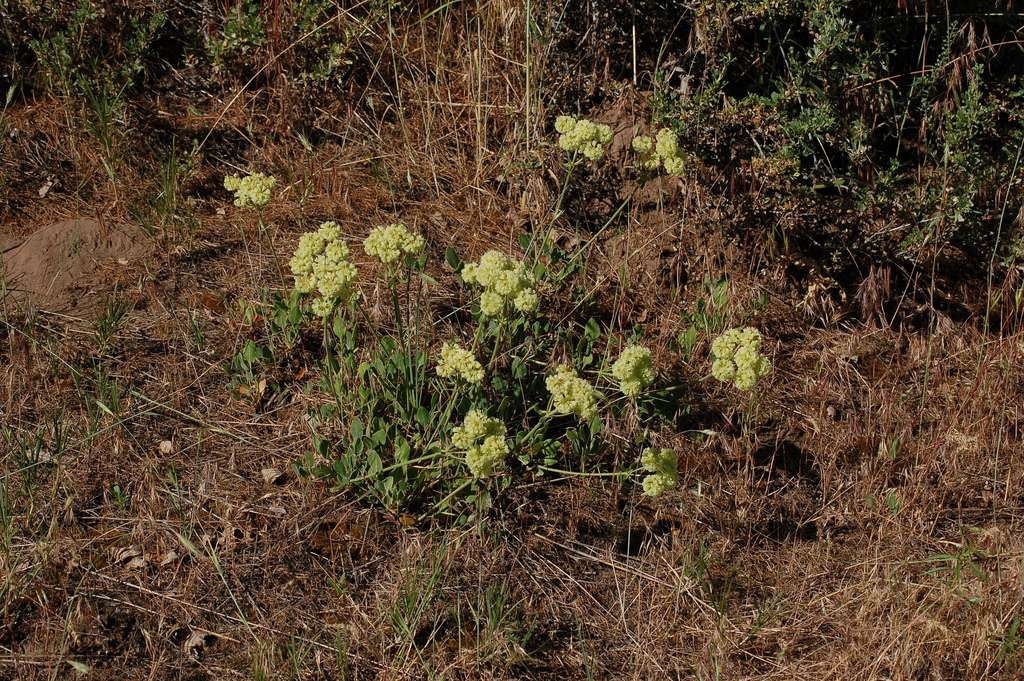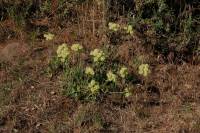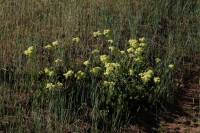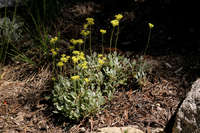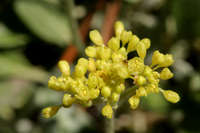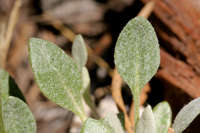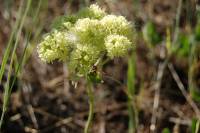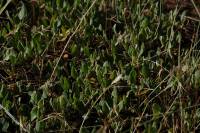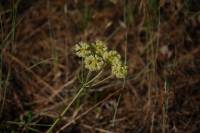Herbs, subshrubs, or shrubs, cespitose, matted or spreading, sometimes erect, often polygamo-dioecious, (0.2-)1-12(-20) × (0.5-)1-12(-20) dm, glabrous or tomentose. Stems: caudex spread-ing; aerial flowering stems spread-ing to erect or nearly so, slender, solid, not fistulose, arising at nodes of caudex branches and at distal nodes of short, nonflowering aerial branches, (0.1-)0.5-3(-4) dm, without a whorl of bracts at midlength. Leaves in loose to compact basal rosettes; petiole 0.1-3(-4) cm, mostly tomentose to floccose or glabrous; blade oblong-ovate or oblanceolate to elliptic to oval, 0.3-3(-4) × 0.1-2.5 cm, densely lanate to tomentose or floccose abaxially, tomentose to floccose or glabrous adaxially, occasionally glabrous on both surfaces, margins entire, plane or rarely wavy. Inflorescences umbellate or compound-umbellate, rarely subcapitate or capitate, 3-25 × 2-18 cm; branches tomentose to floccose or glabrous, rarely with whorl of bracts ca. midlength; bracts 3-several, semileaflike at proximal node, 0.3-2.5 × 0.2-1.8 cm, usually scalelike distally, 1-5 × 0.5-3 mm. Involucres 1 per node, turbinate to campanulate, 1-6 × (1-)1.5-10 mm, tomentose to thinly floccose or glabrous; teeth 6-12, lobelike, reflexed, 1-4(-6) mm. Flowers 2-10(-12) mm, including (0.7-)1.3-2 mm stipelike base; perianth various shades of white, yellow, or red, glabrous; tepals monomorphic, usually spatulate to obovate; stamens exserted, 2-8 mm; filaments pilose proximally. Achenes light brown to brown, 2-7 mm, glabrous except for sparsely pubescent beak.
Herbs, subshrubs, or shrubs, cespitose, matted or spreading, sometimes erect, often polygamo-dioecious, (0.2-)1-12(-20) × (0.5-)1-12(-20) dm, glabrous or tomentose. Stems: caudex spread-ing; aerial flowering stems spread-ing to erect or nearly so, slender, solid, not fistulose, arising at nodes of caudex branches and at distal nodes of short, nonflowering aerial branches, (0.1-)0.5-3(-4) dm, without a whorl of bracts at midlength. Leaves in loose to compact basal rosettes; petiole 0.1-3(-4) cm, mostly tomentose to floccose or glabrous; blade oblong-ovate or oblanceolate to elliptic to oval, 0.3-3(-4) × 0.1-2.5 cm, densely lanate to tomentose or floccose abaxially, tomentose to floccose or glabrous adaxially, occasionally glabrous on both surfaces, margins entire, plane or rarely wavy. Inflorescences umbellate or compound-umbellate, rarely subcapitate or capitate, 3-25 × 2-18 cm; branches tomentose to floccose or glabrous, rarely with whorl of bracts ca. midlength; bracts 3-several, semileaflike at proximal node, 0.3-2.5 × 0.2-1.8 cm, usually scalelike distally, 1-5 × 0.5-3 mm. Involucres 1 per node, turbinate to campanulate, 1-6 × (1-)1.5-10 mm, tomentose to thinly floccose or glabrous; teeth 6-12, lobelike, reflexed, 1-4(-6) mm. Flowers 2-10(-12) mm, including (0.7-)1.3-2 mm stipelike base; perianth various shades of white, yellow, or red, glabrous; tepals monomorphic, usually spatulate to obovate; stamens exserted, 2-8 mm; filaments pilose proximally. Achenes light brown to brown, 2-7 mm, glabrous except for sparsely pubescent beak.
Eriogonum umbellatum is a widespread and exceedingly variable species rivaling Astragalus lentiginosus Douglas ex Hooker in complexity. Only the variety majus is sometimes recognized at the species rank (as E. subalpinum).
In the following key and descriptions, reference is made to 'glabrous' leaf surfaces. This is a function of both age and power of observation. High-power magnification may show some exceedingly fine hairs that are not readily observable to the naked eye. Furthermore, new leaves that ultimately will be 'glabrous' will have some fine-tomentose pubescence that becomes less obvious (or even wholly inconspicuous) as the blade expands and matures. Here, the term 'glabrous' is used to refer to leaves that are not obviously hairy and are typically bright green on both surfaces when the plant is at full anthesis.
There are several reported uses of sulphur flower in the enthobotany literature, mostly without an indication of the variety. J. B. Romero (1954) indicated that in California, where most of the variants are found, an infusion of the flowers is used for ptomaine poisoning, and M. L. Zigmond (1981) stated that the Kawaiisu used mashed flowers as a salve for gonorrheal sores. E. V. A. Murphey (1959), who worked with P. Train et al. (1941), reported that in Nevada members of the species (most likely var. nevadense) were used in the treatment of colds and stomachaches; J. H. Steward (1933) reported the same uses among the Owens Valley Piute in California. Train and his group noted that poultices of leaves and sometimes roots were used for lameness or rheumatism. In Oregon, leaves of var. ellipticum were used in a poultice to soothe pain, especially that resulting from burns (F. V. Coville 1897; L. Spier 1930). Most of the reports associated with the Navajo or Diné people probably relate to the use of var. subaridum. L. C. Wyman and S. K. Harris (1951) found the species used as a disinfectant or an emetic. The Cheyenne people employed a mixture of powdered stems and flowers to halt lengthy menses (G. B. Grinnell 1923; J. A. Hart 1981). According to A. Johnston (1987), the Blackfoot made a tea from boiled leaves.
The cythera metalmark butterfly (Apodemia mormo cythera) is found in association with a few varieties of sulphur flower (G. F. Pratt and G. R. Ballmer 1991). More commonly seen with the species are the Rocky Mountain dotted-blue (Euphilotes ancilla) and lupin
Eriogonum umbellatum is a widespread and exceedingly variable species rivaling Astragalus lentiginosus Douglas ex Hooker in complexity. Only the variety majus is sometimes recognized at the species rank (as E. subalpinum).
In the following key and descriptions, reference is made to 'glabrous' leaf surfaces. This is a function of both age and power of observation. High-power magnification may show some exceedingly fine hairs that are not readily observable to the naked eye. Furthermore, new leaves that ultimately will be 'glabrous' will have some fine-tomentose pubescence that becomes less obvious (or even wholly inconspicuous) as the blade expands and matures. Here, the term 'glabrous' is used to refer to leaves that are not obviously hairy and are typically bright green on both surfaces when the plant is at full anthesis.
There are several reported uses of sulphur flower in the enthobotany literature, mostly without an indication of the variety. J. B. Romero (1954) indicated that in California, where most of the variants are found, an infusion of the flowers is used for ptomaine poisoning, and M. L. Zigmond (1981) stated that the Kawaiisu used mashed flowers as a salve for gonorrheal sores. E. V. A. Murphey (1959), who worked with P. Train et al. (1941), reported that in Nevada members of the species (most likely var. nevadense) were used in the treatment of colds and stomachaches; J. H. Steward (1933) reported the same uses among the Owens Valley Piute in California. Train and his group noted that poultices of leaves and sometimes roots were used for lameness or rheumatism. In Oregon, leaves of var. ellipticum were used in a poultice to soothe pain, especially that resulting from burns (F. V. Coville 1897; L. Spier 1930). Most of the reports associated with the Navajo or Diné people probably relate to the use of var. subaridum. L. C. Wyman and S. K. Harris (1951) found the species used as a disinfectant or an emetic. The Cheyenne people employed a mixture of powdered stems and flowers to halt lengthy menses (G. B. Grinnell 1923; J. A. Hart 1981). According to A. Johnston (1987), the Blackfoot made a tea from boiled leaves.
The cythera metalmark butterfly (Apodemia mormo cythera) is found in association with a few varieties of sulphur flower (G. F. Pratt and G. R. Ballmer 1991). More commonly seen with the species are the Rocky Mountain dotted-blue (Euphilotes ancilla) and lupin
Duration: Perennial
Lifeform: Subshrub, Forb/Herb
General: Perennial, herbaceous, subshrub, or shrub, 10-70 cm tall; stems erect, glabrous or with tuft of long, tangled hairs; caudex short, spreading.
Leaves: Basal (forming loose rosettes), alternate, oblong-ovate, elliptic, or oval, 1-3 cm long, 5-20 mm wide, glabrous to sparsely pubescent with tufts of long, tangled hairs above, sparsely pubescent to densely white-tomentose below, margins entire; petiole 0.1-3 cm long, tomentose to glabrous.
Flowers: Inflorescence raceme-like, tomentose, rarely glabrous; bracts subtending the inflorescence 3, triangular, scale- like, occasionally linear-oblanceolate, to elliptic and leaf-like; peduncles absent or erect, 0.3-4 cm long; involucres 1 per node, top-shaped to campanulate, 2-5 mm long, tomentose, teeth 5, erect; perianth 2-5 mm long, cream-colored to pinkish, glabrous, tepals oblong, connate at the base; flowers June-October.
Fruits: Achene, 2-7 mm long, light brown to brown, glabrous.
Ecology: Grasslands, oak and pinyon-juniper woodlands, ponderosa pine and mixed conifer forests, sandy to gravelly soils; 1200-2700 m (4000-9000 ft); Apache, Coconino, Gila, Mohave, Navajo, and Yavapai counties; southwestern U.S.
Notes: Three varieties occur in our area, and are differentiated as follows: var. cognatum is herbaceous, forming compact mats, the leaves sparsely pubescent above, densely white-tomentose below; var. subaridum is a subshrub to shrub, the leaves sparsely tomentose on both surfaces or glabrous and green above; and var. juniporinum has a whitish, cream, or pale yellow to greenish yellow perianth. Eriogonum jamesii ( James-s buckwheat) is a herbaceous perennial; leaves are basal (typically not in rosettes), narrowly elliptic, 1-3 cm long, tomentose and greenish above, whitish to grayish tomentose below; perianth is white to cream-colored, densely pubescent. It occurs in similar habitats as E. umbellatum. Ours, as here described, is var. jamesii. Eriogonum arcuatum (Baker-s wild buckwheat) [=E. bakeri, E. jamesii var. flavescens] is very similar to E. jamesii, but distinguished by its yellow perianth. Sulphur wild buckwheat, with its vibrant yellow flowers, makes a lovely plant for the dry and sunny native plant garden, especially when planted among purple flowers. It is attractive to butterflies and bees, and is a host plant for Acmon blue and Mormon metalmark butterflies. The Paiutes use it medicinally to treat colds, stomach aches, and rheumatism.
Editor: Springer et al. 2008


